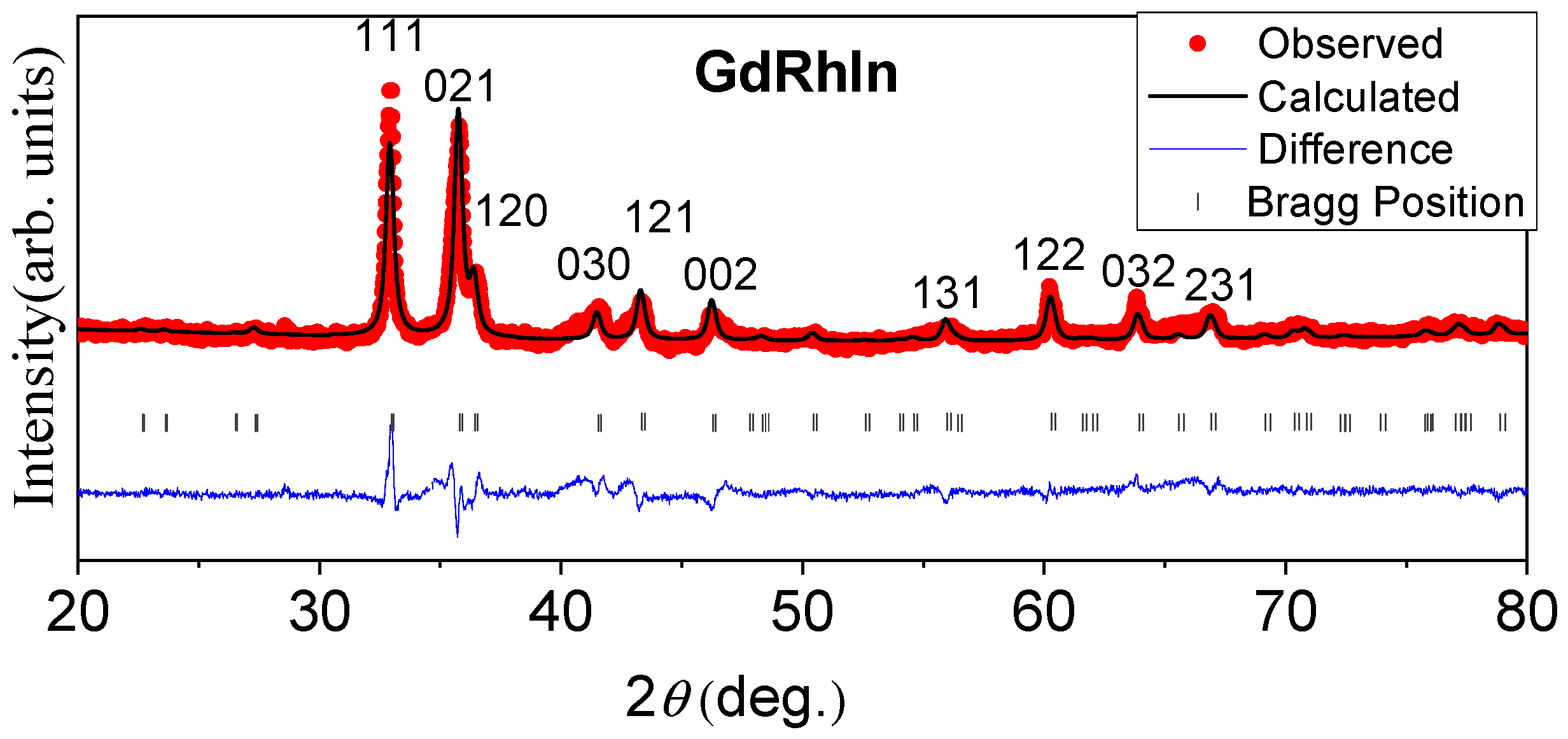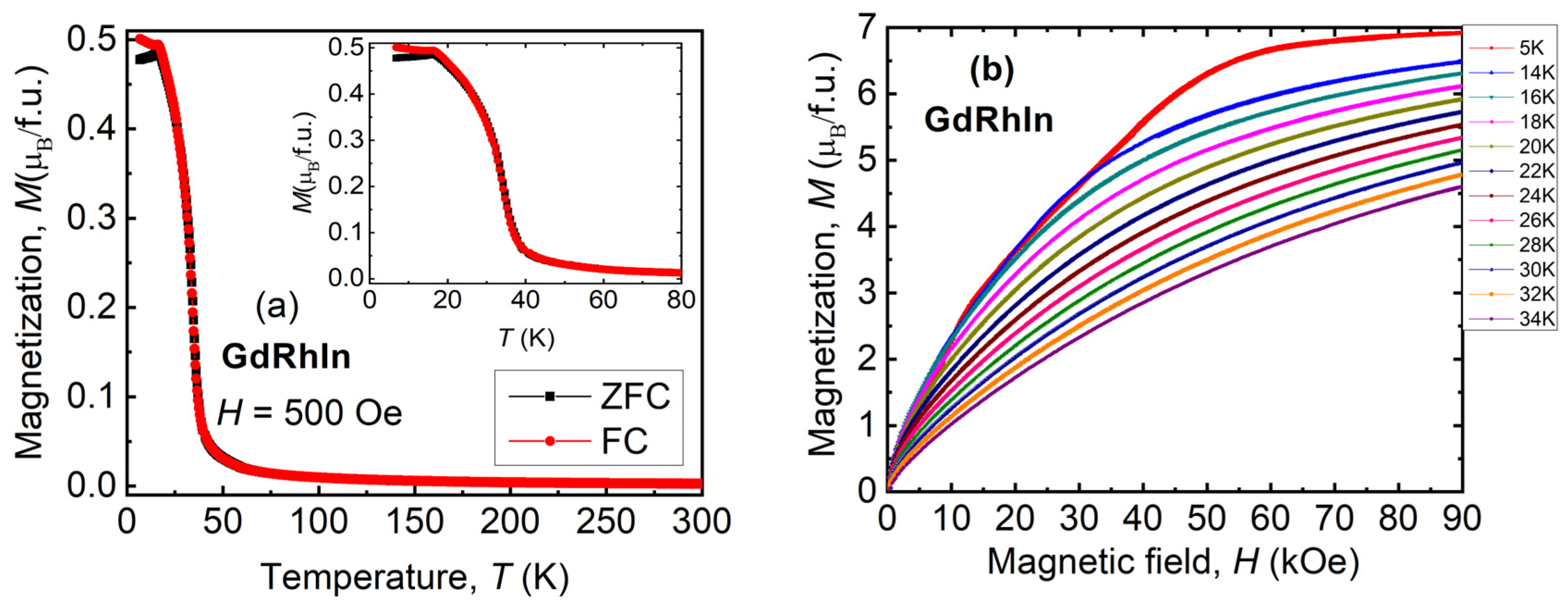Structural, Magnetic, and Magneto-Thermal Properties of Rare Earth Intermetallic GdRhIn
Abstract
:1. Introduction
2. Materials and Methods
3. Results and Discussion
3.1. Crystal Structure
3.2. Magnetic Properties
3.3. Heat Capacity
3.4. Magnetocaloric Effect (MCE)
4. Conclusions
Author Contributions
Funding
Institutional Review Board Statement
Informed Consent Statement
Data Availability Statement
Acknowledgments
Conflicts of Interest
References
- Gupta, S.; Suresh, K.G. Review on Magnetic and Related Properties of RTX Compounds. J. Alloys Compd. 2015, 618, 562–606. [Google Scholar] [CrossRef]
- Gupta, S. Exotic Rare Earth-Based Materials for Emerging Spintronic Technology. In Handbook on the Physics and Chemistry of Rare Earths; Bunzli, J.C., Kauzlarich, S.M., Eds.; Elsevier: Amsterdam, The Nederland, 2023; pp. 99–140. ISBN 01681273. [Google Scholar]
- Skomski, R.; Coey, J. Condensed Matter Physics. In Permanent Magnetism; Institute of Physics Publishing: London, UK, 1999; ISBN 9780750304788. [Google Scholar]
- Gupta, S. Magnetic Phenomena in Equiatomic Ternary Rare Earth Compounds. In Handbook of Magnetic Materials; Elsevier: Amsterdam, The Nederland, 2023; pp. 1–103. ISBN 9780443193729. [Google Scholar]
- Pecharsky, V.K.; Gschneidner, K.A., Jr. Giant Magnetocaloric Effect InGd5(Si2Ge2). Phys. Rev. Lett. 1997, 78, 4494–4497. [Google Scholar] [CrossRef]
- Ohring, M. Magnetic Properties of Materials. In Engineering Materials Science; Elsevier: Amsterdam, The Nederland, 1995; pp. 711–746. ISBN 9780125249959. [Google Scholar]
- Coey, J.M.D. Perspective and Prospects for Rare Earth Permanent Magnets. Engineering 2020, 6, 119–131. [Google Scholar] [CrossRef]
- Cullity, B.D.; Graham, C.D. Introduction to Magnetic Materials; John Wiley & Sons, Inc.: Hoboken, NJ, USA, 2008; ISBN 9780470386323. [Google Scholar]
- Fert, A.; Reyren, N.; Cros, V. Advances in the Physics of Magnetic Skyrmions and Perspective for Technology. arXiv 2017, arXiv:1712.07236. [Google Scholar]
- Ding, M.; Poon, S.J. Tunable Perpendicular Magnetic Anisotropy in GdFeCo Amorphous Films. J. Magn. Magn. Mater. 2013, 339, 51–55. [Google Scholar] [CrossRef]
- Huang, H.-L.; Tung, J.-C.; Jeng, H.-T. A First-Principles Study of Rare Earth Quaternary Heusler Compounds: RXVZ (R = Yb, Lu; X = Fe, Co, Ni; Z = Al, Si). Phys. Chem. Chem. Phys. 2021, 23, 2264–2274. [Google Scholar] [CrossRef]
- Liu, Z.K.; Yang, L.X.; Wu, S.-C.; Shekhar, C.; Jiang, J.; Yang, H.F.; Zhang, Y.; Mo, S.-K.; Hussain, Z.; Yan, B.; et al. Observation of Unusual Topological Surface States in Half-Heusler Compounds LnPtBi (Ln=Lu, Y). Nat. Commun. 2016, 7, 12924. [Google Scholar] [CrossRef]
- Pierre, J.; Karla, I.; Kaczmarska, K. Giant Magnetoresistance in Heusler-Type Rare Earth and 3d Semiconductors. Phys. B Condens. Matter 1999, 259, 845–846. [Google Scholar] [CrossRef]
- Paderni, D.; Giorgi, L.; Fusi, V.; Formica, M.; Ambrosi, G.; Micheloni, M. Chemical Sensors for Rare Earth Metal Ions. Coord. Chem. Rev. 2021, 429, 213639. [Google Scholar] [CrossRef]
- Law, J.Y.; Moreno-Ramírez, L.M.; Díaz-García, Á.; Franco, V. Current Perspective in Magnetocaloric Materials Research. J. Appl. Phys. 2023, 133, 040903. [Google Scholar] [CrossRef]
- Tang, X.; Sepehri-Amin, H.; Terada, N.; Martin-Cid, A.; Kurniawan, I.; Kobayashi, S.; Kotani, Y.; Takeya, H.; Lai, J.; Matsushita, Y.; et al. Magnetic Refrigeration Material Operating at a Full Temperature Range Required for Hydrogen Liquefaction. Nat. Commun. 2022, 13, 1817. [Google Scholar] [CrossRef] [PubMed]
- Nehan, P.Z.Z.; Vitayaya, O.; Munazat, D.R.; Manawan, M.T.E.; Darminto, D.; Kurniawan, B. The Magnetocaloric Effect Properties for Potential Applications of Magnetic Refrigerator Technology: A Review. Phys. Chem. Chem. Phys. 2024, 26, 14476–14504. [Google Scholar] [CrossRef] [PubMed]
- Law, J.Y.; Franco, V. Review on Magnetocaloric High-Entropy Alloys: Design and Analysis Methods. J. Mater. Res. 2023, 38, 37–51. [Google Scholar] [CrossRef]
- Gupta, S.B.; Suresh, K.G. Giant Low Field Magnetocaloric Effect in Soft Ferromagnetic ErRuSi. Appl. Phys. Lett. 2013, 102, 022408. [Google Scholar] [CrossRef]
- Brown, G.V. Magnetic Heat Pumping near Room Temperature. J. Appl. Phys. 1976, 47, 3673–3680. [Google Scholar] [CrossRef]
- Chen, Z.; Zhang, C.; Zhang, Z.; Yu, S.; Zhang, G.; Tu, H.; Wang, D.; Shen, J. Large Magnetocaloric Effect in Gadolinium-Rich Silicate NaGd9(SiO4)6O2. J. Alloys Compd. 2024, 976, 173351. [Google Scholar] [CrossRef]
- Endichi, A.; Bouhani, H.; Baggari, O.; Zaari, H.; Mounkachi, O.; Kenz, A.E.; Benyoussef, A. Insights into the Magnetocaloric Effect of Gadolinium: A DFT Exploration of Structural, Electronic, and Magnetic Features in Bulk and Film Configurations. arXiv 2024, arXiv:2402.09979. [Google Scholar]
- Xu, L.; Qian, C.; Ai, Y.; Su, T.; Hou, X. Tunable Magnetocaloric Properties of Gd-Based Alloys by Adding Tb and Doping Fe Elements. Materials 2019, 12, 2877. [Google Scholar] [CrossRef] [PubMed]
- Lukachuk, M.; Zaremba, V.I.; Pöttgen, R. Synthesis and Crystal Structures of RERhIn (RE=Sm, Tb, Ho, Er, Tm, Yb, Lu). Intermetallics 2003, 11, 581–587. [Google Scholar] [CrossRef]
- Ferro, R.; Marazza, R.; Rambaldi, G. On Some Ternary Alloys of the Rare Earths Having the Fe2P-Type Structure. Z. Anorg. Allg. Chem. 1974, 410, 219–224. [Google Scholar] [CrossRef]
- Rossi, D.; Mazzone, D.; Marazza, R.; Ferro, R. A Contribution to the Crystallochemistry of Ternary Rare Earth Intermetallic Phases. Z. Anorg. Allg. Chem. 1983, 507, 235–240. [Google Scholar] [CrossRef]
- Abyadeh, M.; Gupta, V.; You, Y.; Paulo, J.A.; Mirzaei, M. Visualizing Traumatic Brain Injury: Ocular Clues for Diagnosis and Assessment. Neural Regen. Res. 2025, 20, 1399–1400. [Google Scholar] [CrossRef] [PubMed]
- Adroja, D.T.; Malik, S.K.; Padalia, B.D.; Vijayaraghavan, R. CeRhIn: A New Mixed-Valent Cerium Compound. Phys. Rev. B Condens. Matter 1989, 39, 4831–4833. [Google Scholar] [CrossRef]
- Pöttgen, R.; Hoffmann, R.-D.; Möller, M.H.; Kotzyba, G.; Künnen, B.; Rosenhahn, C.; Mosel, B.D. Syntheses, Crystal Structures, and Properties of EuRhIn, EuIr2, and EuIrSn2. J. Solid State Chem. 1999, 145, 174–181. [Google Scholar] [CrossRef]
- Gupta, S.B.; Suresh, K.G. Study of Magnetocaloric Effect in GdRhIn Compound. AIP Conf. Proc. 2013, 1512, 1090–1091. [Google Scholar]
- Rodríguez-Carvajal, J. Recent Advances in Magnetic Structure Determination by Neutron Powder Diffraction. Phys. B Condens. Matter 1993, 192, 55–69. [Google Scholar] [CrossRef]
- Elliott, R.J. (Ed.) Magnetic Properties of Rare Earth Metals; Springer: Boston, MA, USA, 1972; ISBN 9781475756937. [Google Scholar]
- Malik, S.K.; Takeya, H.; Gschneidner, A.K. The Low Temperature Behavior of Some Light Lanthanide RRhSb and RPdSb Compounds. J. Alloys Compd. 1994, 207, 237–240. [Google Scholar] [CrossRef]
- Gupta, S.; Suresh, K.G.; Nigam, A.K. Observation of Large Positive Magnetoresistance and Its Sign Reversal in GdRhGe. J. Alloys Compd. 2014, 586, 600–604. [Google Scholar] [CrossRef]
- Gopal, E.S.R. Specific Heats at Low Temperatures; Springer: Boston, MA, USA, 1966; ISBN 9781468490831. [Google Scholar]
- Erode, S.R.G. Specific Heats at Low Temperatures; The International Cryogenics Monograph Series; Kluwer Academic/Plenum: New York, NY, USA, 1966; ISBN 9780306302220. [Google Scholar]
- Kim, M.-S.; Echizen, Y.; Umeo, K.; Kobayashi, S.; Sera, M.; Salamakha, P.S.; Sologub, O.L.; Takabatake, T.; Chen, X.; Tayama, T.; et al. Low-Temperature Anomalies in Magnetic, Transport, and Thermal Properties of Single-Crystal CeRhSn with Valence Fluctuations. Phys. Rev. B Condens. Matter Mater. Phys. 2003, 68, 054416. [Google Scholar] [CrossRef]
- Mihalik, M.S. Vladimír Magnetic Properties of PrRhSn: A Single-Crystal Study. J. Magn. Magn. Mater. 2007, 310, 1758–1760. [Google Scholar] [CrossRef]
- Zhang, H.; Xu, Z.Y.; Zheng, X.Q.; Shen, J.; Hu, F.X.; Sun, J.R.; Shen, B.G. Magnetocaloric Effects in RNiIn (R = Gd-Er) Intermetallic Compounds. J. Appl. Phys. 2011, 109, 123926. [Google Scholar] [CrossRef]
- Herrero, A.; Oleaga, A.; Manfrinetti, P.; Provino, A.; Salazar, A. Study of the Magnetocaloric Effect in Intermetallics RTX (R = Nd, Gd; T = Sc, Ti; X = Si, Ge). Intermetallics (Barking) 2019, 110, 106495. [Google Scholar] [CrossRef]
- Gupta, S.; Suresh, K.G.; Nigam, A.K.; Mudryk, Y.; Paudyal, D.; Pecharsky, V.K.; Gschneidner, K.A., Jr. The Nature of the First Order Isostructural Transition in GdRhSn. J. Alloys Compd. 2014, 613, 280–287. [Google Scholar] [CrossRef]
- Kuchin, A.G.; Platonov, S.P.; Mukhachev, R.D.; Lukoyanov, A.V.; Volegov, A.S.; Gaviko, V.S.; Yakovleva, M.Y. Large Magnetic Entropy Change in GdRuSi Optimal for Magnetocaloric Liquefaction of Nitrogen. Metals 2023, 13, 290. [Google Scholar] [CrossRef]
- Xiao, G.; Wang, B.; Yang, T.; Zhao, Q.; Yang, W.; Ren, Z.; Li, H.-F.; Cai, Y.; Lai, S. Successive Magnetic Transitions and Magnetocaloric Performances in RE3Co2Ge4 (RE = Gd, Tb and Dy) Compounds. J. Rare Earths. 2024. [Google Scholar] [CrossRef]
- Hayyu, A.R.; Baran, S.; Szytuła, A.; Berent, K.; Deptuch, A. Characterization of Magnetic Properties, Including Magnetocaloric Effect, of RE5Pt2In4 (RE = Gd-Tm) Compounds. J. Alloys Compd. 2024, 1001, 175054. [Google Scholar] [CrossRef]
- Zhang, Q.; Liu, X.G.; Yang, F.; Feng, W.J.; Zhao, X.G.; Kang, D.J.; Zhang, Z.D. Large Reversible Magnetocaloric Effect in Dy2In. J. Phys. D Appl. Phys. 2009, 42, 055011. [Google Scholar] [CrossRef]




| Material | ΔSM (J/kg K) at 50 kOe | RC (J/kg) at 50 kOe | Reference |
|---|---|---|---|
| GdScSi | 3.7 | 133.2 * | [40] |
| GdScGe | 4.0 | 135.3 * | [40] |
| GdRhSn | 6.5 | - | [41] |
| GdRhGe | ~1 | - | [34] |
| GdRuSi | 10.7 | 336 | [42] |
| Gd3Co2Ge4 | 7.9 | 184 | [43] |
| Tb3Co2Ge4 | 3.6 | 70 | [43] |
| Gd5Pt2In4 | 2.2 | 139 | [44] |
| Tb5Pt2In4 | 1.7 | 165 | [44] |
| GdRhIn | 8 | 282 | This Work |
Disclaimer/Publisher’s Note: The statements, opinions and data contained in all publications are solely those of the individual author(s) and contributor(s) and not of MDPI and/or the editor(s). MDPI and/or the editor(s) disclaim responsibility for any injury to people or property resulting from any ideas, methods, instructions or products referred to in the content. |
© 2024 by the authors. Licensee MDPI, Basel, Switzerland. This article is an open access article distributed under the terms and conditions of the Creative Commons Attribution (CC BY) license (https://creativecommons.org/licenses/by/4.0/).
Share and Cite
Kumar, R.; Maz, A.A.; Mishra, S.K.; Gupta, S. Structural, Magnetic, and Magneto-Thermal Properties of Rare Earth Intermetallic GdRhIn. Sensors 2024, 24, 6326. https://doi.org/10.3390/s24196326
Kumar R, Maz AA, Mishra SK, Gupta S. Structural, Magnetic, and Magneto-Thermal Properties of Rare Earth Intermetallic GdRhIn. Sensors. 2024; 24(19):6326. https://doi.org/10.3390/s24196326
Chicago/Turabian StyleKumar, Ravinder, Arrab Ali Maz, Satyendra Kumar Mishra, and Sachin Gupta. 2024. "Structural, Magnetic, and Magneto-Thermal Properties of Rare Earth Intermetallic GdRhIn" Sensors 24, no. 19: 6326. https://doi.org/10.3390/s24196326







